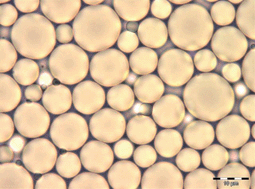 Researchers from France have described a new method of combining an in vitro digestion method with a Caco 2 cell model to study lipid digestion, absorption and conversion to lipid bodies and used this to study the influence of the structure of dietary lipid sources during digestion.
Researchers from France have described a new method of combining an in vitro digestion method with a Caco 2 cell model to study lipid digestion, absorption and conversion to lipid bodies and used this to study the influence of the structure of dietary lipid sources during digestion.
Until recently, studies on dietary fats only considered the impact of their global intake and their total fatty acid composition, not their structure in foods. By understanding the intake and absorption of dietary oils, diseases such as obesity, diabetes and atherosclerosis (which are characterised by a high fat diet) can be better understood.
In this work, four emulsions based on milk fat olein (OL) or rapeseed oil (RA) as the dispersed phase and either lecithin or sodium caseinate as the emulsifier were examined. It was demonstrated that in vitro digestion fluids resulting from food emulsions could be used to incubate on Caco-2 cells as a new model for testing emulsion digestion and absorption. It was also shown that the emulsion composition influenced the activation of lipid metabolism and TAG secretion.
To read the full article, click the link below. Read it for free until 23rd March.
Coupling in vitro gastrointestinal lipolysis and Caco-2 cell cultures for testing the absorption of different food emulsions, Cecile Vors, Perrine Capolino, Clemence Guerin, Emmanuelle Meugnier, Sandra Pesenti, Marie-Agnes Chauvin, Julien Monteil, Noel Peretti, Maud Cansell, Frederic Carriere and Marie-Caroline Michalski, Food Funct., 2012, DOI: 10.1039/c2fo10248j
You may also be interested in this review article which is free to access
Review of in vitro digestion models for rapid screening of emulsion-based systems
David Julian McClements and Yan Li
Food Funct., 2010, 1, 32-59, DOI: 10.1039/C0FO00111B
You can keep up to date with the latest developments from Food & Function by signing up for free table of contents alerts and monthly e-newsletters.










